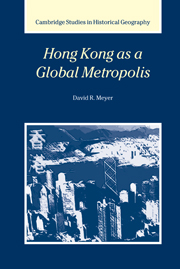Book contents
- Frontmatter
- Contents
- List of figures
- List of maps
- List of tables
- Preface
- 1 Enigma
- 2 Intermediaries of capital
- 3 From Canton to Hong Kong
- 4 Hub of the China trade
- 5 Chinese and foreign social networks of capital
- 6 Trade and finance center for Asia
- 7 Industrial metropolis
- 8 Global metropolis for Asia
- 9 Hong Kong, China
- Bibliography
- Index
- Cambridge Studies in Historical Geography
5 - Chinese and foreign social networks of capital
Published online by Cambridge University Press: 28 July 2009
- Frontmatter
- Contents
- List of figures
- List of maps
- List of tables
- Preface
- 1 Enigma
- 2 Intermediaries of capital
- 3 From Canton to Hong Kong
- 4 Hub of the China trade
- 5 Chinese and foreign social networks of capital
- 6 Trade and finance center for Asia
- 7 Industrial metropolis
- 8 Global metropolis for Asia
- 9 Hong Kong, China
- Bibliography
- Index
- Cambridge Studies in Historical Geography
Summary
In all the old staple branches of China commerce, the broker is taking the place of the merchant, or the merchant is becoming a virtual broker. When the period of transition is over, no doubt most of the larger firms with capital and credit will have transferred themselves from produce to industrial and financial enterprises – and will become, in fact, private bankers. Those of them, who, like ourselves have the management of steam lines and insurance offices are the luckiest, and it is significant that Jardines, Heards and others are all struggling to develop this branch of business.
Transformation of transportation and communication
Technological innovations after 1860 that sharply raised the quality and speed of transportation and communication and lowered their cost enhanced the exchange of commodity and financial capital over the vast distances that separated Europe and North America from the Far East. Fixed dates mark these innovations: the opening of the Suez Canal in 1869 and the immediate rush to build steamships for Europe-Asia trade, and the start of telegraphic communication between Europe and the metropolises of Singapore, Hong Kong, and Shanghai by 1871. Their timing implies that they reshaped Asian trade and finance and powered economic growth and development of the region into the early twentieth century. The innovations produced time–space and cost-space convergence: distant places drew closer together, and the most widely separated, which included Asia, Europe, and North America, captured greater relative benefits (fig. 2.2).
- Type
- Chapter
- Information
- Hong Kong as a Global Metropolis , pp. 78 - 113Publisher: Cambridge University PressPrint publication year: 2000



